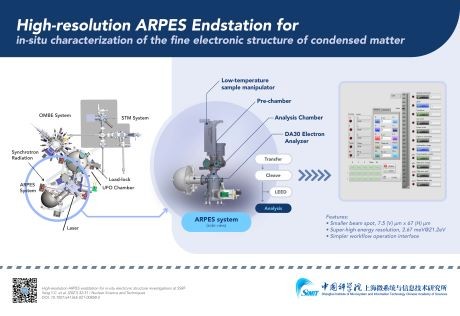博文
改进的角分辨光电子能谱(ARPES)使原位表征凝聚态的精细电子结构成为可能
|
Article title: High-resolution ARPES endstation for in-situ electronic structure investigations at SSRF
SSRF现场电子结构调查的高分辨率ARPES终端站
DOI:10.1007/s41365-021-00858-2
One sentence summary:
An ARPES endstation with smaller beam spot, super-high energy resolution, and much simpler work flow allows in-situ characterization of the fine electronic structure of condensed matter.
一句话概要:
ARPES端站具有更小的束斑、超高的能量分辨率和更简单的工作流程,可以原位表征凝聚态物质的精细电子结构。
http://www.nst.sinap.ac.cn/newsDetails/112/3089/en/

The Novelty (What)
To meet the high requirements of sophisticated studies in condensed matter physics, this research has successfully designed and constructed a more advanced synchrotron angle-resolved photoemission spectroscopy (ARPES) beamline (BL03U) and an endstation at the Shanghai Synchrotron Radiation Facility (SSRF). The BL03U endstation consists of an ARPES system, a load-lock chamber, an oxide molecular beam epitaxy (OMBE) system, a scanning tunneling microscopy (STM) system, and a UFO-like transfer chamber. The beam spot produced by the ARPES system is as fine as 7.5 mm (V) × 67 mm (H) with the fundamental photon range of 7 to 165 eV. Photoemission with an energy resolution of 2.67 meV (at 21.2 eV photon energy) was achieved by the newly developed ARPES system. By equipping the ARPES system with a six-axis cryogenic sample manipulator (minimum temperature of 7 K), the BL03U endstation provides an essential platform to carry out in-situ characterization of the electronic structure of condensed matter. Such a development has demonstrated the versatility of an ARPES endstation to be enhanced to support future studies in condensed matter physics.
创新性(主要内容)
为了满足凝聚态物理研究的高要求,本研究成功地在上海同步辐射装置(SSRF)上设计和建造了一条更先进的同步角分辨光电子能谱(ARPES)光束线(BL03U)和一个端站。 BL03U终端站由ARPES系统、负载锁定室、氧化物分子束外延(OMBE)系统、扫描隧道显微镜(STM)系统和类UFO传输室组成。 ARPES系统产生的光束光斑为7.5m(V)×67m(H),基光子范围为7~165eV。 利用新研制的ARPES系统实现了能量分辨率为2.67meV(光子能量为21.2eV)的光电子发射。 通过为ARPES系统配备六轴低温样品机械手(最低温度为7 K),该BL03U端站为开展凝聚态电子结构原位表征提供了必不可少的平台。 这一发展表明了ARPES终端站的多功能性,有待加强,以支持凝聚态物理的未来研究。
The Background (Why)
Conventional ARPES is well-known for its capability in characterizing the electronic properties of correlated materials and the electronic structure of correlated electron systems. Nonetheless, conventional ARPES faced several bottlenecks when it was applied in the recent development of quantum materials which has higher characterization requirements in terms of photon energy, flux, and beam spot. Besides that, quantum material samples with a flat surface along the desired crystalline orientation were difficult to be prepared for characterization under ARPES. To address these limitations, a more superior ARPES endstation has been developed by this study. Furthermore, with the OMBE system and connected growth chamber, epitaxial growth techniques are able to be applied to realize in-situ ARPES measurements without the need for tedious sample preparation. By having the state-of-the-art features, this facility will boost the advancement of studies in condensed matter physics.
研究背景(主要原因)
传统的ARPES在表征关联材料的电子性质和关联电子体系的电子结构方面具有广泛的应用前景。 然而,传统的ARPES在量子材料的发展中遇到了一些瓶颈,这些量子材料对光子的能量、通量和光束光斑有更高的表征要求。 此外,在ARPES下很难制备出沿所需晶体取向的平坦表面的量子材料样品用于表征。 为了解决这些限制,本研究开发了一个更优越的ARPES端站。 此外,利用OMBE系统和连接的生长室,外延生长技术可以实现原位ARPES测量,而不需要繁琐的样品制备。 通过拥有最先进的功能,这一设施将推动凝聚态物理研究的进展。
The SDG impact (Big Why)
The improvement of ARPES will help condensed matter physicists to better understand the behavior of more exotic condensed phases include the superconducting phase exhibited by certain materials at low temperature. More experiments can be conducted using the improved facility to measure various material properties, and by applying the physical laws of quantum mechanics, electromagnetism, statistical mechanics, and other theories to develop mathematical models.
Such innovative facility is a great contribution to the research infrastructure that supporting and aligning to the UNSDG 9: Industries, Innovation & Infrastructure.
SDG影响力(研究意义)
ARPES的改进将帮助凝聚态物理学家更好地理解更多奇异的凝聚态相的行为,包括某些材料在低温下表现出的超导相。 利用改进后的设备可以进行更多的实验来测量各种材料的性质,并应用量子力学、电磁学、统计力学和其他理论的物理定律来建立数学模型。
这种创新设施是对支持和符合联合国可持续发展目标9:工业、创新和基础设施的研究基础设施的巨大贡献。
https://blog.sciencenet.cn/blog-3474219-1366040.html
上一篇:通过动态几何信息交换提高液基探测器模拟精度
下一篇:为离子电荷分辨而研发的改进型等时性质谱术